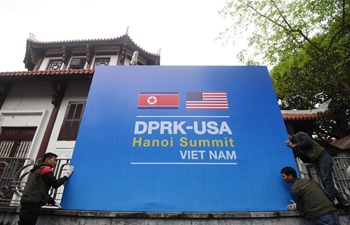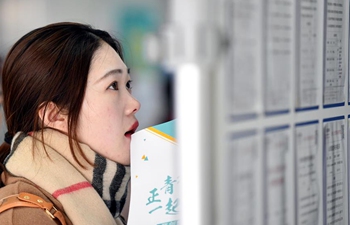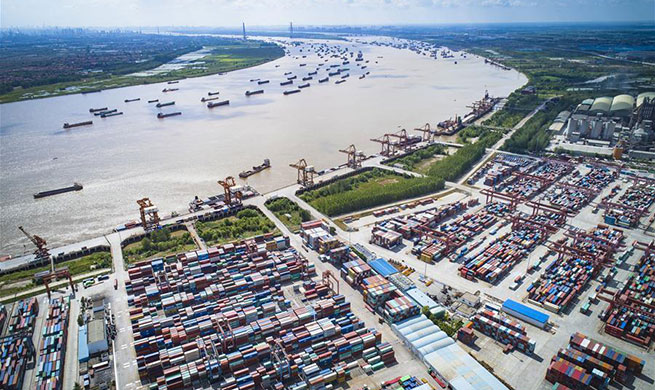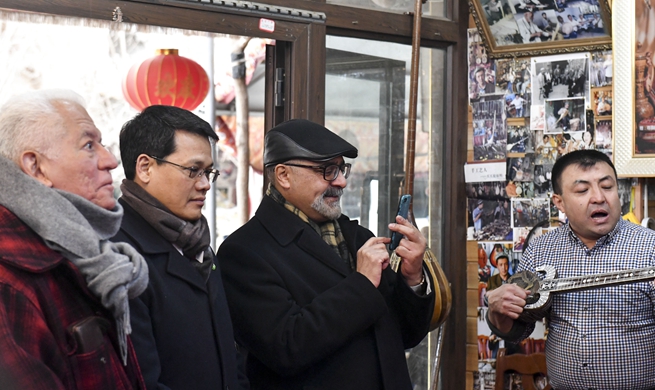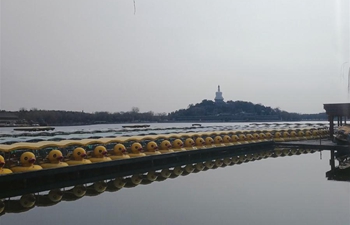ROME, Feb. 26 (Xinhua) -- From footwear to high-end chocolate, Italian small-and-medium enterprises (SMEs) are betting on China amid signs of falling exports and slowing growth.
Italy's SMEs are the backbone of the country's industrial and manufacturing system, and they have "an elevated vocation towards exports", Stefano Menghinello, the Director of Business Statistics at national statistics bureau ISTAT, told an October 2018 Senate hearing in a report titled "The Positioning of Italy in International Trade."
In 2017, at least 45.4 percent of Italian manufacturers were selling their products abroad, and many of these were SMEs, Menghinello told lawmakers, adding that "a comparison with other large European countries shows that Italian SMEs have a distinctly greater weight on national exports."
IMPORTANT MARKET FOR FOOTWEAR EXPORTS
Among these SMEs are Italy's celebrated shoemakers, whose products are coveted by customers around the world -- and, increasingly, in China, which is currently the ninth most important market for Italian footwear exports, according to Annarita Pilotti, the president of Assocalzaturifici Italian shoe manufacturers association.
The footwear sector has yearly turnover of over 14 billion euros, employs 77,000 people, and exports 85 percent of its products, according to Assocalzaturifici, which represents 600 companies and which earlier this month held the MICAM trade fair in Milan, where the focus was on China as the next business frontier.
"This year, for the first time, we assigned the MICAM Award to a Chinese buyer... a clear indication of the market's liking for (our trade fair)," Pilotti told Xinhua.
Pilotti explained that "the typical Chinese buyer is interested prevalently in women's shoes and appreciates high-end footwear", and that in order to fully succeed in China, companies must think about "penetrating (its) so-called 2nd and 3rd-tier cities."
"The Chinese market is very atypical," Pilotti said. "It's not enough to export shoes to Shanghai or Beijing to say you have covered the whole market."
Assocalzaturifici has recently identified a potential market stretching from southern to central China: areas that are making rapid technological progress and that have a high population growth rate, according to Pilotti.
"The enormous interest Italian-made products are attracting ...means two things: on the one hand, that the promotional activity undertaken to sustain Made-in-Italy goods abroad is paying off, and on the other, that Italian manufacturing is unique," Pilotti pointed out.
"The 'made-in' trademark is seen as a guarantee, the expression of a specific cultural identity associated with high-end luxury products, sophisticated design and high-quality materials: all characteristics that are typical of Italian-made footwear," she said.
LOOKING EAST AMID EXPORTS SLOWDOWN
While there was a boom in Chinese demand for Italian footwear last year, Italy's exports overall posted a slowdown in the latter part of 2018, falling on both a monthly basis (-2.3 percent ) and a yearly basis (-2.7 percent), according to ISTAT.
This was due to a number of factors, including contracting global growth, which according to the January 2019 World Economic Outlook report by the International Monetary Fund, looks set to continue this year.
Nevertheless, Italy's state-controlled investment bank Cassa Depositi e Prestiti (CDP) and its trade arm SACE SIMEST are putting their financial muscle behind Italian companies trying to expand into the Asian market, notably China. Last week, CDP and UniCredit bank announced they have entered into a partnership to support Italian companies in China, setting up a 300-million-euro revolving line of credit plus co-financing and renminbi-denominated funding instruments.
"While many Italian companies are active on the foreign market, the majority of them still belongs to the category of 'occasional exporter'," said SACE, which currently operates in some 190 countries around the world through a range of services that include export credit, credit insurance, and financial guarantees. "The companies that are actually capable of reaching an elevated and diversified number of markets with medium- to long-term strategies are still relatively few."
SACE, therefore, set itself a "double objective" in its 2016-2020 industrial plan: to take more Italian companies abroad, and to strengthen the companies that already operate there by expanding their markets and promoting innovation. These include a 4.5-billion-euro investment in a new program called Push Strategy, which offers lines of credit at competitive interest rates to foreign multinationals for the purchase of Italian goods and services.
On a smaller scale, SACE SIMEST recently announced a direct investment of four million euros plus a 4.5-million-euro loan guarantee to support the Asian expansion of Venchi, a historic Italian chocolate and ice cream maker that was founded in the northern Italian city of Turin in the 1800s.
Venchi currently has over 100 single-brand stores, of which 47 are located in Italy and the rest are in major cities around the world including Beijing, Hong Kong, London, and New York, and it plans to open more shops in Asia in 2019-2023.

